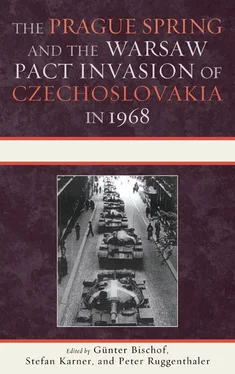74. On this, see also Prozumenshchikov, “Inside the Politburo of the CPSU,” in this volume.
75. Telegram from the ambassador of the GDR in Prague, 18 July 1968, SAPMOBA, DY 30/ 3618, p. 1.
76. Priess et al., Die SED und der “Prager Frühling , ” 206–9.
77. Rüdiger Wenzke, Forschungen zur DDR-Geschichte , vol. 5, Die NVA und der Prager Frühling 1968: Die Rolle Ulbrichts und der DDR-Streitkräfte bei der Niederschlagung der tschechoslowakischen Reformbewegung (Berlin: Ch. Links, 1995).
78. Wenzke, Forschungen zur DDR-Geschichte , 5:211–12.
79. Wenzke, Forschungen zur DDR-Geschichte , 5:202; on this see also the protocols of the NVR from the year 1968, Bundesarchiv , 2008 http://www.bundesarchiv.de/fb_daofind/Zdaofind_DVW1_NVR/mets/NVR_39490/index.htm(accessed 21 June 2008).
80. On this, see also Prozumenshchikov, “Inside the Politburo of the CPSU,” in this volume and Vondrová, “Prag und Moskau,” 171–92.
81. Priess et al., Die SED und der “Prager Frühling , ” 213.
82. Pauer, Der Einmarsch des Warschauer Paktes , 173.
83. Pauer, Der Einmarsch des Warschauer Paktes , 174.
84. Pauer, Der Einmarsch des Warschauer Paktes , 174.
85. Hermann Axen (1916–1992): 1932 member of the Communist Youth Organization; imprisoned after 1933, inc. in Auschwitz concentration camp; 1945 KPD; 1970–1989 member of the Politburo of the SED, Central Committee secretary for international affairs.
86. Priess et al., Die SED und der “Prager Frühling , ” 215.
87. Pauer, Der Einmarsch des Warschauer Paktes , 175.
88. RGANI, F. 3. op. 72, d. 197, pp. 3–6, Politburo resolution of the Central Committee of the CPSU P 95 (I), 17 August 1968, reprinted in Karner et al., Dokumente , #62.
89. SAPMO-BA, DY 30/3621, pp. 57–61, minutes of the discussion between members of the delegations of the SED and the KSČ, 13 August 1968, reprinted in Karner et al., Dokumente , #86; RGANI, F. 89, op. 76, d. 73, pp. 1–2, Politburo resolution of the Central Committee of the CPSU P 94 (82), 10 August 1968, reprinted in Karner et al., Dokumente , #54.
90. On the significance of this discussion for the forming of opinion in the Central Committee apparatus of the CPSU, see also Prozumenshchikov, “Inside the Politburo of the CPSU,” in this volume.
91. RGANI, F. 3. op. 72, d. 197, pp. 3–6 (see note 2).
92. Pauer, Der Einmarsch des Warschauer Paktes , 228–62.
93. On this, see Manfred Wilke, “Protokoll der 47: Sitzung der EnqueteKommission: Der Prager Frühling 1968 und Solidarnosc 1980/81,” in Materialien der Enquete-Kommission der 12. Wahlperiode des Deutschen Bundestages , vol. 1, ed. Der Deutsche Bundestag (Baden-Baden: Nomos, 1995), 170; AdBIK, holding “Prager Frühling,” stenographical record of the meeting of the interventionist coalition in Moscow, 18 August 1968, reprinted in Karner et al., Dokumente , #87.
94. Priess et al., Die SED und der “Prager Frühling , ” 226–84, and Pauer, Der Einmarsch des Warschauer Paktes , 283–391.
95. SAPMO-BA, DY 30/11836, pp. 1–116 (see note 59).
96. Boris Meissner, Die Sowjetunion im Umbruch (Stuttgart: Deutsche VerlagsAnstalt, 1988).
97. Memorandum on a discussion between the general secretary of the Central Committee of the SED and chairman of the State Council of the GDR, Comrade Erich Honecker, and the member of the Presidium and secretary of the Central Committee of the KSČ, Comrade Vasil Bil’ak, on 24 November 1988 in the offices of the Central Committee, SAPMO-BA, DY 30/2439, p. 3.
98. SAPMO-BA, DY 30/2439, 5.
99. Robert Havemann, Fragen Antworten Fragen: Aus der Biographie eines deutschen Marxisten (Munich: R. Piper, 1970), 59.
16
Hungary and the Prague Spring
Csaba Békés
The reform movement in the Czechoslovak Socialist Republic (ČSSR) that began in January 1968 coincided with the introduction of the “new economic mechanism” in Hungary. 1The Hungarian leadership saw three possible scenarios on which to base a prognosis regarding the potential consequences of the events in Prague on Hungary. In the best-case scenario, the Czechoslovak reforms would remain moderate; they would, if reluctantly, be accepted by the Soviets in a development that was analogous to that in Poland in October 1956. In this case, Hungary and Czechoslovakia, the two leading reformist countries within the Soviet Bloc, would be able to support each other and serve as an example to the other countries. This would echo the first half of the 1960s, when Hungary and Poland had played a leading role in de-Stalinization.
In a second, much more probable scenario, the Czechoslovak reforms, which were above all political in nature, would sooner or later—perhaps even contrary to the original intentions of their initiators—move beyond the limits set by the Soviet leadership. This would ultimately lead to an armed intervention on the pattern of Hungary 1956 and could seriously jeopardize all initiatives and reforms in the Soviet Bloc that deviated from the Soviet model, including the Hungarian economic reforms.
In the third scenario, the far reaching political reforms in Prague might prove unacceptable to Moscow, which could lead to Hungary’s course of moderate restructuring, which did not threaten political destabilization, being given a green light as the lesser of two evils. A comparison of the two processes, which differed in their objectives, might even awaken a certain amount of sympathy on the part of the Soviet leadership for the downright moderate Hungarian reforms, which only aimed at improving economic efficiency and indirectly also served Soviet interests. It was, in fact, this third scenario which was turned into reality in 1968 and the ensuing years. The Soviet leadership, after being rather tolerant at the beginning, exerted substantial pressure on the Hungarian leadership in the early 1970s to prevent the reforms from leading to the country’s destabilization, and they made sure that the leading reformists were removed. János Kádár himself was not removed, however, whereas Władysław Gomułka and Walter Ulbricht were both forced to resign from their posts during those years; the most important measures of the Hungarian economic reform were allowed to remain in place.
Since the beginning of 1968, it was quite clear that there was only one objective for Kádár and the Hungarian leadership: to do everything in their power to make the first scenario come true. Failing that, the next one in order of preference was the third one; the second one, discrediting all reforms, was to be avoided at all costs. This determination was the driving force behind Kádár’s repeated attempts to persuade the Czechoslovak leaders to be cautious, to slow down the pace of reform, to acknowledge realities while he worked hard up to the middle of July, and even after that to convince the Kremlin and the other Soviet Bloc leaders to muster more understanding and patience because the cause of socialism was not yet critically endangered there.
It is important to make it quite clear from the outset that the difference of opinion between Kádár and the Soviets and/or the other Socialist leaders did not concern the question whether the Soviet Union and the member states of the Warsaw Pact were entitled to intervene if a restoration of capitalism was to be attempted in Czechoslovakia. Kádár had given an unequivocal answer to that question at the session of the Central Committee of the Hungarian Socialist Workers’ Party (HSWP) held on 19 and 20 June 1968:
If we conclude that this is a counterrevolution and that the counterrevolution is gaining the upper hand, then, quite frankly and if truth be told here among us, one has to go to the limit, and I would raise both my hands in favour of those Warsaw Pact countries that are prepared to do so occupying Czechoslovakia. This is what has to be done because the socialist world cannot afford to lose Czechoslovakia. 2
Читать дальше












